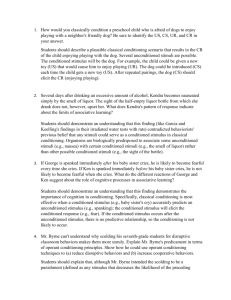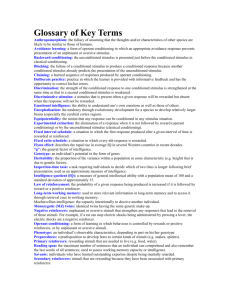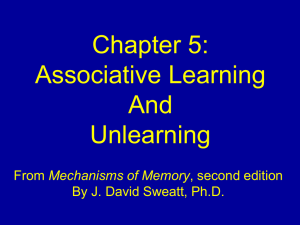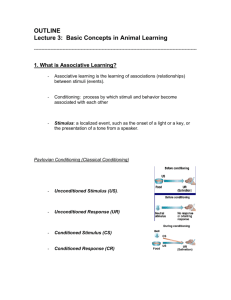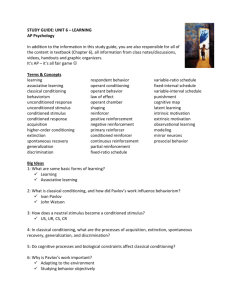Psyc 100 Chapter 5 (Sensation and Perception) & 6 (Learning)
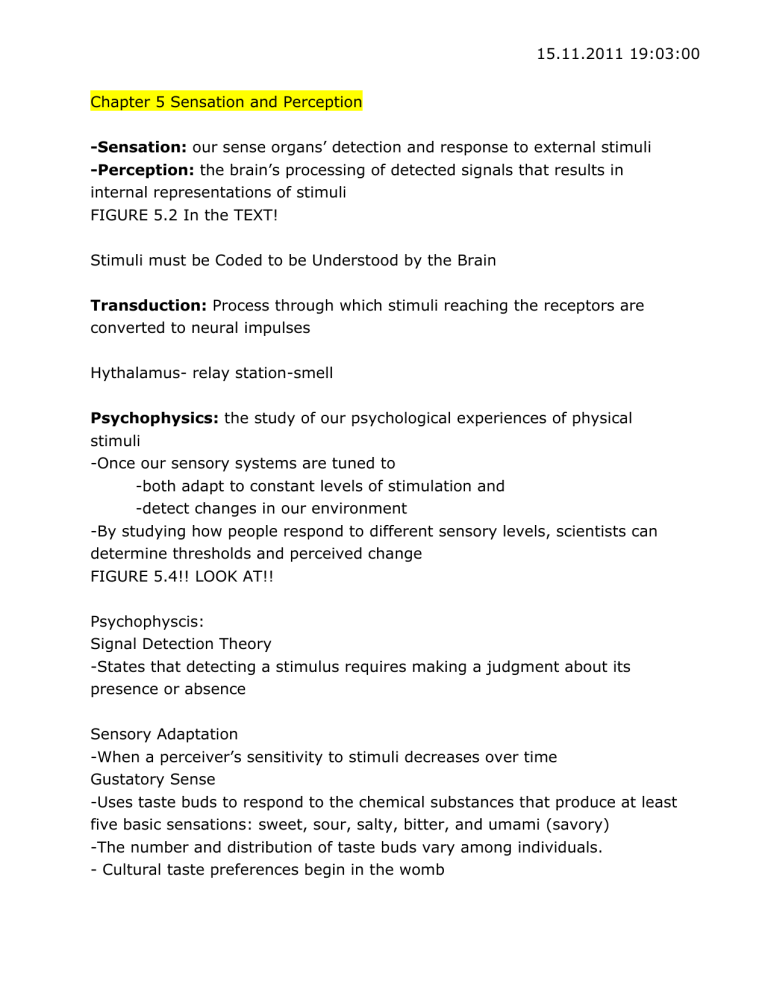
15.11.2011 19:03:00
Chapter 5 Sensation and Perception
-Sensation: our sense organs’ detection and response to external stimuli
-Perception: the brain’s processing of detected signals that results in internal representations of stimuli
FIGURE 5.2 In the TEXT!
Stimuli must be Coded to be Understood by the Brain
Transduction: Process through which stimuli reaching the receptors are converted to neural impulses
Hythalamus- relay station-smell
Psychophysics: the study of our psychological experiences of physical stimuli
-Once our sensory systems are tuned to
-both adapt to constant levels of stimulation and
-detect changes in our environment
-By studying how people respond to different sensory levels, scientists can determine thresholds and perceived change
FIGURE 5.4!! LOOK AT!!
Psychophyscis:
Signal Detection Theory
-States that detecting a stimulus requires making a judgment about its presence or absence
Sensory Adaptation
-When a perceiver’s sensitivity to stimuli decreases over time
Gustatory Sense
-Uses taste buds to respond to the chemical substances that produce at least five basic sensations: sweet, sour, salty, bitter, and umami (savory)
-The number and distribution of taste buds vary among individuals.
- Cultural taste preferences begin in the womb
Smell
-Olfaction: our sense of smell
-Olfactory Epithelium: thin layer of tissues in the nasal cavity embedded with smell receptors
-Receptors respond to chemicals and send signals to the olfactory bulb in the brain
-Females are significantly more accurate than males at detecting and identifying odors
FIGURE 5.11 LOOK!!!
Touch
-Haptic Sense: Relies on tactile stimulation to activate receptors for temperature, for sharp or dull pain, and for other sensations
FIGURE 5.12 LOOK!!
-Gate Control Theory: Neural “gates” in the spinal cord also control pain
-We can reduce pain perception by:
-Distraction
-Visualizing pain as more pleasant
-Being rested and relaxed
-Learning how to change brain activity that underlies pain perception
_ Taking drugs that interfere with the neural transmission of pain or render us unconscious
Hearing
-Sound originates from displacement or air molecules
-This “sound wave” travels the auditory canal, causes the eardrum to vibrate
-Activate different hair cells in the inner ear
-This results in neural firing
FIGURE 5.14 & 5.16 LOOOK!
Vision
-Light wave first pass through the cornea
-Pass through the lens, focuses image on the retina
-The pupil determines how much light gets in
-Receptors int eh retina detect different forms of light waves
-Rods-night vision
-Cones- vision in high illumination
DIFFERENCE BTW RODS AND CONES!? EXAM
Cones are about fine detil in high illumination*
From the Eye to the Brain
-Retinal photorecpetors translate light into neural impulses
-The message travels the optic nerve to the brain
-Processed by the thalamus and then sent to the primary visual cortex
Sensory Deprivation
-What happens when we limit sensory input?
November 7 th ,2011
Figure 5.19
The point at which the optic nerve exits the retina contains no rods or cones, creating a blind spot.
VISION CONTINUED:
Receptive Field:
-Particular visual neurons respond best to particular “tunings” (particular colors, shapes, motions).
-The region of space to which neurons in the primary visual cortex are sensitive is the receptive field.
Lateral Inhibition:
-Visual systems are sensitive to edges
-If a rod or cone is stimulated, it sends information to its neighboring receptors, inhibiting their activity
Figure 5.21
Color & Vision
-Color is determined by:
- wavelengths of light, which activate certain types of cones
- the absorption of wavelengths by objects
- or by mixing of wavelengths of light
Color Continued
-Subtractive color mixing: means the mixture occurs within the stimulus and is a physical process
-ie: paint mixing
-Additive color mixing : occurs when lights of different wavelengths are mixed
-ie: stage lighting
Color Vision
-An object appears to be a particular color because of the wavelengths it reflects
-Three cone populations are called “S” (short), “M” (medium) and “L” (long)
-Different colors are determined by the ratio of activity among the three types of cones
Figure 5.26- receptors adapt to the colors then you are centrally seeing there opposing colors..blue and red
Staring at the squares called the McCollough Effect vertical = puplue an horizontal = yellow
Simultaneous Contrast
-Simultaneous contrast: an optical illusion in which identical stimuli appear different when presented against different backgrounds.
Other Sensory Systems
- In addition to the five “basic” senses, humans and other animals have:
*Kinesthetic sense
-ability to judge where one’s limbs are in space
*Vestibular sense
-abiltiy to compare one’s bodily position to the upright position
-Some animals can use sound waves and disruptions in an electrical field to navigate
Evidence for Extrasensory Perception (ESP) Is Weak or Nonexistent
-Little or no evidence supports the intriguing idea that some people have additional sensory systems (Ie: to read minds or predict the future)
-The Intention Experiment
Critical thinking Skill
-Understanding that perception can be deceiving
-Magic tricks are designed to fool your basic senses
Body Image Distortion: A Case if Distorted Perception
25% larger than what we are
50% think larger abdomen men do not distort about themselves.. however that is changing now a days
What Kind of factors influence this: media, mood,
Chapter 6 ; learning
Three Major Areas
-Classical conditioning
-Operant Conditioning
-Social learning
What is learning?
-Learning is a relatively enduring change in behavior resulting from experience
-If two events occur close together, people will form an association between them.
Why is learning important?
Learning is essential to our survival
Understanding how we develop fears
Understanding how to create new association, or change old ones
Understanding and predicting behavior
Origins of learning theory
Key players
Pavlov
J.b Watson
…..
Key theories
Classical conditioning
B.F skinner .… Operational conditioning
Albert Bandura … social learning
Pavlov:
Russian scientist studying the digestion of dogs
Noted that dogs began salivating before food even arrived
Discovered that the sound of the researcher approaching elicited salivation in the dogs.
The dogs had been conditioned to salivate then because of repeated pairings of footsteps+ food.
FIGURE 6.3
His theory: Classical conditioning
Unconditioned stimulus (US)
-Stimulus that already evokes a response
Unconditioned response (UR)
- Response that already follows the stimulus
Conditioned stimulus (CS)
-New stimulus that evokes response after conditioning
Conditioned response (CR)
Response that now follows conditioned stimulus
The UCR (think “natural” or “unlearned”) and CR( think “learned”) are the same, but elicited by a different stimulus.
-Acquisition: the gradual formation of an association between the conditioned and unconditioned stimuli.
-Extinction occurs when the conditioned stimulus (CS) no longer predicts the unconditioned stimulus (US)
Spontaneous recovery
Extinction burst!
Watson
Can fears be conditioned?
“Little Albert”
Repeated pairings of US (loud noise) with CS (white rat)
After several trails- fearful reaction (CR) to white rat
Tidbit: Creating a Fetish
One of the theories of how Fetishism develops is:
-Via classical conditioning
Conditioning & Advertising: The “celebrity endorsement”
B.F. Skinner
Considered to be the founder of operant conditioning
Focused on the observable behaviors of pigeons and rats rather than the study of the mind through introspection
Skinner’s systematic studies led to many of the principles of learning we know today and have been influential in many areas from classrooms to clinics
What is operant conditioning?
A learning process in which the consequences of an action determine the likelihood that it will be performed in the future.
How does operant conditioning differ from classical conditioning?
Classical conditioning is a passive associational process that does not take into account when organisms engage in instrumental behavior (to achieve some purpose).
Operant (aka instrumental) conditioning is the learning process in which an action’s consequences determine the likelihood that the action will be performed in the future.
Some key terms to know!
Reinforcement
-Positive vs. negative
-Primary vs. secondary
Punishment
-Positive punishment
-Negative punishment
Positive reinforcers: anything that follows a behavior that increases the likelihood that that behavior will reoccur
Negative reinforcer: anything that, when removed, increases the likelihood that a behavior will reoccur. like PR’s, NR’s increase a behavior. Unlike PR’s, NR’s are aversive stimuli.
Promotes escape and avoidance
Reinforcement Increases Behavior:
Reinforceres can be grouped into 2 types;
Primary: those satisfying basic biological needs.
Secondary: those that do not satisfy basic biological needs- learned through classical conditioning. …. “ tuck shop with kids”
Premack Principal
David Premack : the premack principle (AKA grandma’s rule) suggests that more valued activities can be used to reinforce less valued activities.
“Grandma’s Rule”-> “ first you finish your broccoli, then you get your desert.”
Operant Conditioning: Punishers
Punishers: anything that follows a behavior that decreases the likelifhood of that behavior reoccurring.
(Punishers differ from NR’s in that punishers decrease a behavior while NR’s
increase (via escape and avoidance) a behavior)
- Punishment can involve the application of an aversive or removal of a positive

